Fermentation is an age-old technique used to preserve fresh foods. It is used to make alcohol from fruits and grains, but also to acidify and improve flavor in a variety of other foods.
In the world of peppers, you’re probably most familiar with fermentation in the form of Tabasco sauce. This vinegar-rich hot sauce starts with a fermented mash of Tabasco chiles.
Today, I want to share a simple recipe to make your own homemade fermented pepper mash. This recipe takes just a few ingredients, and makes the perfect base for crafting your own hot sauce.

What is fermentation and how to do it safely
Fermentation is a biological process that breaks down fresh organic ingredients. In the case of peppers and other fresh produce, we use lacto-fermentation.
With lacto-fermentation, we rely on the presence of lactobacillus, a type of bacteria that is common on plants around the world. Lactobacillus breaks down sugars into lactic acid, causing your ingredients become less sweet, and more acidic, thereby preserving the food.
Fun fact: Lactobacillus is a highly-beneficial probiotic, known to treat and prevent cancer (source).
To encourage the lactobacillus to thrive in fermentation, we need to create the right conditions:
- Anaerobic. Lactobacillus is an anaerobic bacteria, meaning that it will only live in an oxygen-free environment. So, we have to make sure that our fermented mash is kept anaerobic.
- Highly salty. Most bacteria cannot grow in a salt environment, but lactobacillus can. In order to avoid other bacterium from competing, we must create a salty environment that lactobacillus doesn’t mind.
With these two important conditions met, we can trust that our ferment will not spoil, and that the lactobacillus will multiply and do their job.
Tips for successful fermentation
As you prepare your fermented mash, keep these important tips in mind:
- Fermentation produces CO2 gas (explosions can happen 😱). If you use a sealed lid without a way for gas to escape, your jars will build pressure. It is critical to “burp” your lids daily during active fermentation to allow the CO2 gas to escape. You should hear a little “pop” when you loosen the lid, at which time you can reseal it until tomorrow. I have had some extra-active ferments that needed multiple burps per day!
- Don’t heat the ferment. Never cook your ingredients before adding them to a fermented mash. The heat will kill off the lactobacillus, leading to a failed ferment. The fresher the ingredients, the better.
- Avoid direct sunlight. While your ferment is active, keep it in a dark, room-temperature spot. The warmer the ferment becomes, the faster it will take place. I find the best flavor develops right around 70°F.
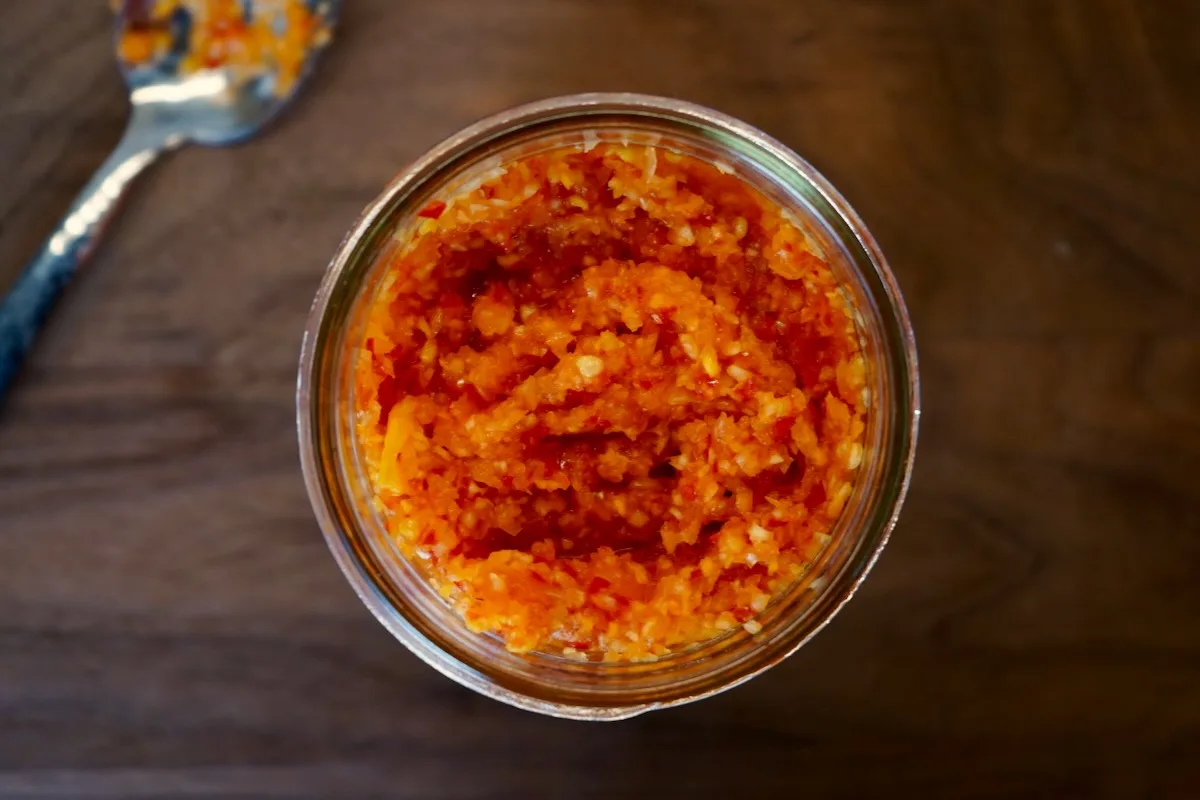
How to make a fermented pepper mash (steps)
As you go through this recipe, keep in mind that the weight of your ingredients is important. The percentage of salt in your ferment is critical for safety, so I highly recommend weighing your ingredients for precision.
Supplies:
- Glass jars (I use wide-mouth size)
- Air-lock lids (optional but recommended)
- Food processor or blender
- Parchment paper (optional)
- Try this fermentation kit for an easy start
Ingredients:
- Mix of hot and sweet peppers, chopped (about 200 grams)
- ½ white onion, chopped (about 100 grams)
- 2-3 medium carrots, peeled and chopped (about 150 grams)
- 3 cloves garlic, crushed (about 20 grams)
- 2.5% sea salt by weight (about 12 grams)
Note: As you can see, this fermented mash recipe includes a few ingredients that are not peppers. If you want a pure pepper mash, that is completely okay, just be sure to weigh them and measure out the correct amount of salt.
Steps:
- Rinse ingredients under cold water.
Remove any excess dirt from your produce by rinsing gently under cold water. No need to scrub vigorously. Pat the ingredients dry.
- Prepare and weigh fresh ingredients.
Peel the carrots. Roughly chop the carrots, peppers, and onions. Crush the garlic. Weigh all ingredients on a scale in grams and make a note of the total weight.
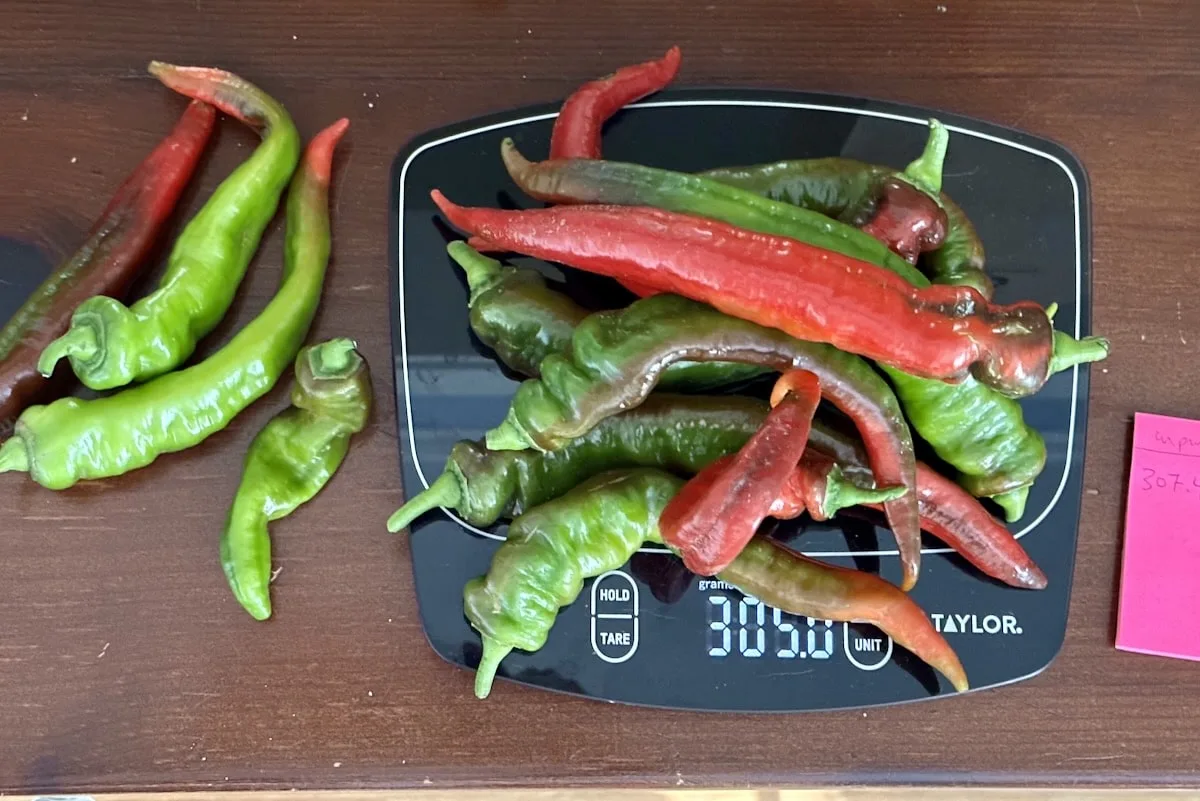
- Weigh out the salt.
Multiply the total weight of the fresh ingredients by 0.025 (2.5%). In this recipe, we had a total fresh ingredient weight of 470 grams. So, to get 2.5% salinity, we’ll need about 12 grams of kosher or sea salt. You can also add more salt if desired, but we usually stay between 2.5-3.5% for our fermented mashes.
- Pulse fresh ingredients in a food processor.
Add the chopped produce to a food processor. Pulse the processor a few times to get the ingredients to a finely-diced consistency.
- Add salt and allow to sit.
Add the salt evenly over the surface of the ingredients. Stir the mixture gently to incorporate the salt. After a few minutes, the salt will begin to draw moisture out of your fresh ingredients, creating a small amount of liquid. This is natural brine which helps keep the mixture anaerobic.
- Blend the mash.
Blend the mixture until it is finely diced. I aim for a chunky hot sauce consistency.

- Add the mix to jars.
Carefully pour your salted ingredients into a clean glass jar. Make sure the jar isn’t oversized, as you want the mash to come to within 1″ of the top. Too much headspace can lead to mold growth.
- Add a cartouche (optional).
To protect the surface of the mash, you can add a cartouche. This can be a piece of parchment paper cut into a circle, or even a grape leaf. The goal is to prevent oxygen from reaching the surface of your mash. Press the cartouche onto the top of the mash, covering it completely.
- Seal the jars with an airlock lid.
Airlock lids allow gas to escape, but not to re-enter your vessel. We have tried a variety of airlocks, but the most reliable are either these from Ball, or classic water airlocks.

- Ferment for 3-4 weeks.
Place the mash in a room-temperature location out of direct sunlight. It can help to monitor the temperature where you plan to ferment to make sure it isn’t too hot or cold. Aim for anywhere between 68-72°F.
Tasting your ferment
After a few weeks, you should check on your ferment. You may notice air pockets showing up on the sides of your jars, which is a good thing! These aren’t actually air, but CO2 created by the lactobacillus.
When you open your ferment, you may notice a slightly “funky” smell. This is normal. However, the mix should not smell foul and/or rancid. Ideally, it will smell pickled and acidic with a hint of sweetness. Think saurkraut or kimchi.
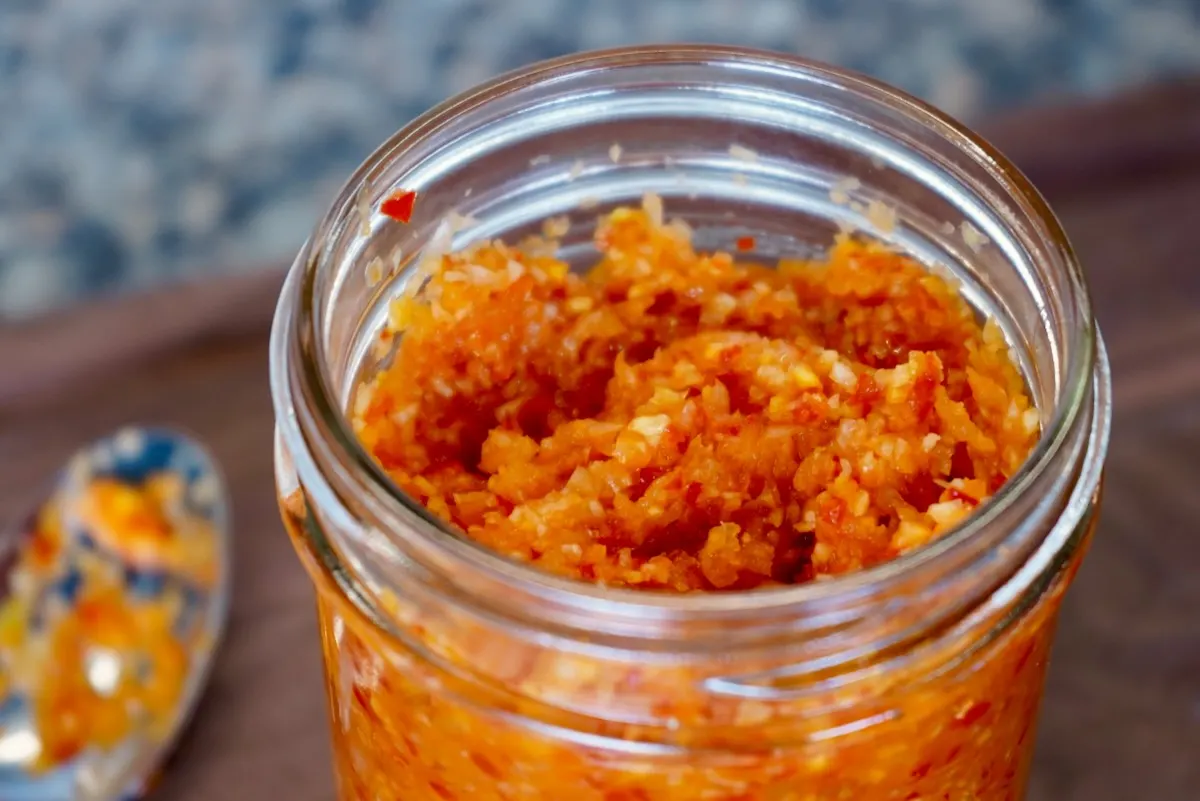
There should be no signs of fuzzy mold on your ferment. If there is, I simply spoon it off and throw it away. The underlying mash should still be brightly colored and not slimy.
If you want extra peace of mind, you can test your ferment with a pH meter. There is no need to ferment to a highly acidic level, but I aim for at least a pH of 4.5 or lower before considering the ferment “complete.” This is the pH below which botulinum toxin can no longer grow.
Once you are sure the ferment has not gone bad, it’s time for a taste! There is no “perfect” amount of fermentation. Some people prefer a lightly fermented mash, while others like to let it go a long time for that extra-funky zing. If you’re happy, then the ferment is ready.
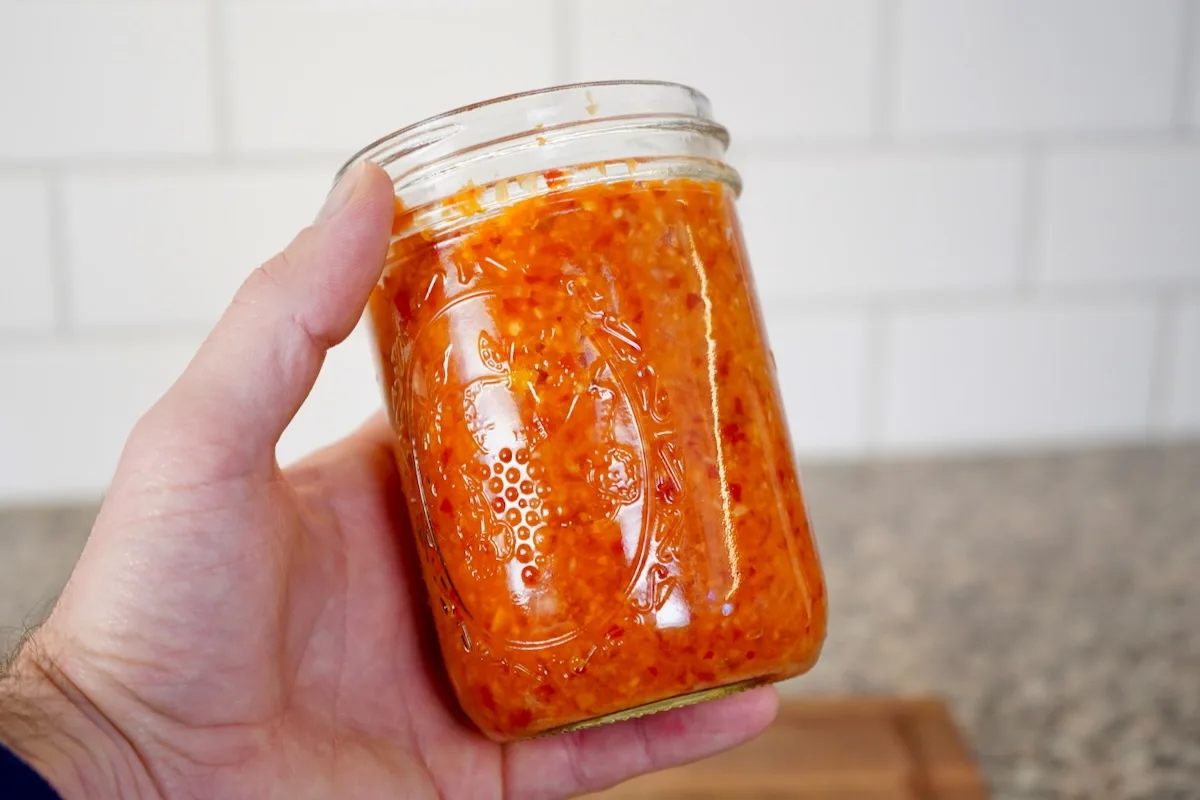
Storing fermented mash
Once your mash is finished to your standards, you have 2 main options for storage:
- In the fridge. My preference is to always store ferments in the refrigerator. The cold temperature essentially halts the fermentation process by slowing the lactobacillus to a stand-still. This is the best way to preserve the flavor for many, many months (or longer).
- Make hot sauce. At any time, your ferment can be used as a base for making hot sauce. Whether you want to take a crack at Louisiana-style hot sauce, or you just want to add a touch of vinegar and spices, fermented mash is an amazing ingredient. This is especially true if you use your hot pepper harvests for this fermented mash recipe.
How To Make Fermented Hot Sauce
Once you have your homemade pepper mash, you can easily make it into a tasty hot sauce. There are a few ways I like to do this, depending on the end goal:
Thicker Hot Sauce
Plain fermented pepper mash is pretty delicious on its own, so I usually like to simply add a few tablespoons of high-quality vinegar, maybe a bit of honey, blend it in a high-powered blender, and bottle it up.
You can also play with herbs and spices at this point, adding your own blend to compliment the flavor of the base mash. I like oregano, thyme, cumin, ginger root, turmeric, black pepper, and garlic powder, to name a few.
If the sauce is too thick, add a teaspoon of vinegar at a time, reblending until the sauce is at your desired consistency. I like to start with small batches to make sure the flavors work together.
Vinegar Sauce (Louisiana Style)
If you are a fan of thin, Tabasco-style sauces, you can infuse your fermented mash into white vinegar. To do this, mix the mash with white vinegar at a 1:1 ratio. Allow the mix to sit at room temperature, stirring it at least once per day.
After a few weeks, strain the sauce and bottle the liquid. You can use the remaining pulp to make a delicious dehydrated fermented powder (a delicious, unique spice in the kitchen!).
Note: Either way you choose to make sauce, you should always store it in the fridge. At room temperature, the sauce may continue to ferment, leading to burst hot sauce bottles.
Common problems with fermentation
If you’re new to fermentation, then chances are you’ve got a few failures ahead of you. But don’t let this discourage you! There are many different ways to ferment your peppers, and always something new to learn.
Common problems:
- Failing to start fermenting. Like I said, fermentation requires the presence of lactobacillus bacteria. This is found on almost any living plant, which is why it’s important to use the freshest ingredients possible (ideally, straight from your garden). Avoid frozen or cooked foods, and if you bought from the store, choose organic produce to avoid pesticide residue. If all else fails, you can add a fermentation starter to your mash to kick-start the process.
- Kahm yeast. After a few weeks of fermenting, you may notice a smooth, cloudy white, slimy-looking substance on the surface of your mash. As long as it doesn’t look fuzzy (like mold), it is probably just kahm yeast. This is a harmless yeast that is common in fermented foods, and can simply be removed from your ferment and thrown away.
- Mold. If you see green, black, or white fuzzy spots on your ferment, it is likely mold. Unlike kahm yeast, molds will be spotty and show up at random. Remove any mold as soon as you see it with a clean utensil and watch for further signs of growth. Once the ferment is acidic enough, mold growth should be much less common.
- Exploding jars. This is why I always use an airlock lid. If you seal your jar with a closed lid, pressure will build and may lead to a dangerous explosion. If you insist on not using an airlock, be vigilant about burping the lid daily during the first few weeks of your ferment. Missing even a single day could lead to disaster!
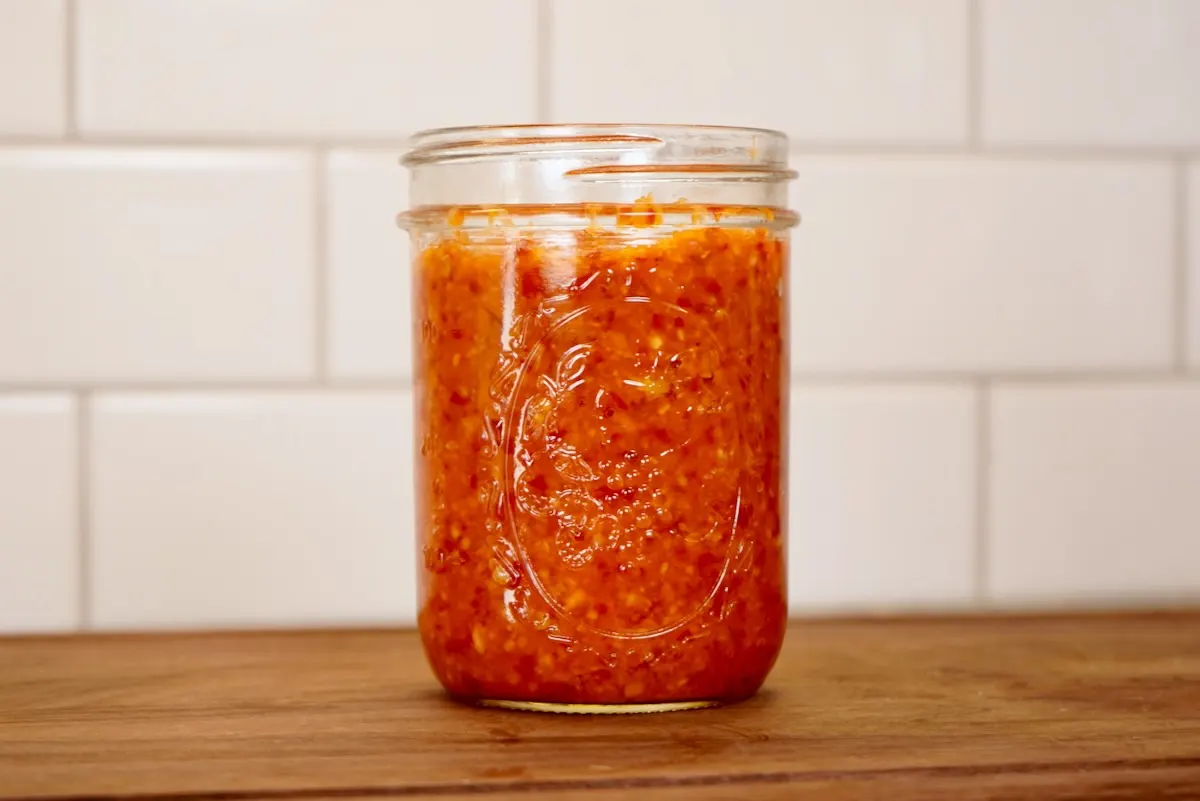
I hope you enjoy making your own homemade fermented pepper mash! Every year, we make a fresh batch of mixed hot pepper mash, and use it to make hot sauce and to flavor home cooked meals. Let us know any fermentation tricks you’d like to share in the comments below.
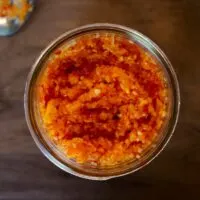
Fermented Pepper Mash
Equipment
- Glass jars wide mouth is ideal
- food processor or blender
- Parchment paper for making a cartouche, optional
Ingredients
- 200 grams hot and sweet peppers chopped
- 150 grams carrots chopped
- 100 grams white onion chopped
- 3 cloves garlic crushed (about 20 grams)
- Sea salt 2.5% weight of fresh ingredients (about 12 grams)
Instructions
- Rinse and rough chop the fresh ingredients.
- Weigh the ingredients in grams and make note of the total.
- Weigh out the salt at 2.5% of the total weight of the produce. Example: If you had 400 grams of fresh ingredients, you would use 10 grams of salt.
- Add fresh ingredients to food processor and pulse a few times.
- Add salt and stir, allowing to sit for 1-2 minutes until moisture releases.
- Blend again until fairly smooth.
- Add to jars and press down to release all air pockets from the mash. Leave about 1 inch of headspace at the top of the jar. Any more, and there is a greater risk of mold. With less headspace, the jars may overflow with liquid as it ferments.
- Cover with an airlock lid and ferment at room temperature out of direct sunlight for 3-4 weeks, checking in after the first 2 weeks. If you do not use an airlock lid, burp the jars at least once a day.
- Once the ferment has reached the desired flavor, refrigerate or use it to create a fermented hot sauce.


tania
Wednesday 29th of November 2023
i have glass 'weights' that I use in my jars when doing pickles to keep ingredients below the liquid line. Can that be used as a cartouche?
peppergeek
Monday 4th of December 2023
Yes, this serves a similar purpose. However, with this mash, you might not have enough liquid to submerge the ingredients. The cartouche does a better job of just covering up the surface of the mash, where a weight is better for full-sized ingredients.